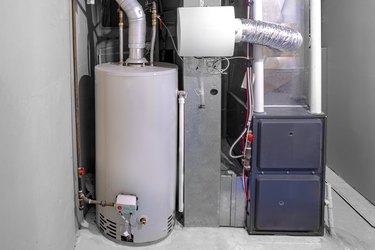
Finding water on the floor of your basement around your air conditioning or heating system isn't a good way to start or end your day. This water — called condensate in this case — is a common byproduct of air conditioning systems as well as many newer furnaces, boilers, and water heaters. If you've determined that the condensate pump is indeed the problem, replacement may be necessary. Wiring for a replacement condensate pump can be easy with some basic knowledge of your system.
Condensate Pump Selection
Video of the Day
Selecting the right pump is the most important thing to start with. Condensate pumps come in different sizes and voltages. Most gas furnaces, boilers, and water heaters use standard voltage (110/115/120 volts), so a standard power supply for the condensate pump is usually readily available. On many air conditioning systems, the air handler, which is where the condensate pump is generally located, uses high voltage (220/230/240 volts). Another thing to consider when selecting a condensate pump is whether or not your pump has a float switch built in. Be sure to get the right pump for your specific application.
Video of the Day
Condensate Pump Wiring
Once you've selected and purchased the right pump for your application, providing power to the pump may be as easy as plugging in a lamp. Most condensate pumps today have a plug end and can be plugged into a GFCI-protected outlet. Some may have an odd-shaped plug that will be used in a 220/230/240-volt type of application. In either case, the outlet should be on a dedicated circuit.
Some pumps must be hardwired and come with a stripped wire cord end or other type of connection. These power connections must be made in a junction box and must comply with the National Electrical Code. Be sure to read the instructions to ensure proper wiring. At this point, it may be time to call a professional — either an electrician or an HVAC pro if you are not comfortable with electrical wiring.
Float Switch Wiring
Most condensate pumps have an internal switch that interrupts the system if the pump fails or the piping is plugged. This is done using a float switch built into the pump. The switch is called a dry contact. This means the power comes from an outside source and the switch provides nothing more than an interruption of that power source. The switches are usually rated for low voltage, such as 24 volts. The switch is used for safety to protect the system and keep it from continuously flooding.
Wiring this is fairly easy, especially if you're simply replacing the pump like for like. It doesn't matter which wire goes where and isn't directional, just wire it as it was originally wired. If you find that your system flooded and the switch wasn't utilized or if the old pump didn't come with one built in, that can be a little less simple but not impossible in an HVAC system. Here might be a good time to consult an HVAC professional or an electrician.
Check Your Work
Turn the power back on and test your work. Be sure that the appliance associated with the new condensate pump runs as it did before. Unplug the condensate pump or isolate the power source and fill the pump basin with water. See if your appliance runs or not. If it runs, make sure you've filled the basin with enough water so that it activates the float switch. You'll know the switch is working when it interrupts the system operation. Finally, plug the pump back in (or restore power), let the pump run, and make sure there are no leaks.